Organic traffic represents all users who visit your website from a non-paid organic search result.
53% of a website’s traffic comes from organic search results with a total of more than 40% of the revenue generated by this channel. This is probably due to the fact that most Internet users find answers to their queries from organic search results.
This traffic is therefore a very important element for webmasters, as it is the first source of visibility for their website and also an ideal way to increase their revenues. But for this to be possible, it is important to know how to optimize it.
So,
- What does organic traffic mean?
- How important is it for a website?
- How to optimize organic traffic?
These are all questions that we will have to answer in the rest of this article. Let’s follow together.
Chapter 1: Organic traffic – What is it?
In this first part, we will have to discuss what is organic traffic, where to find it in Google analytics and how not to confuse it with direct traffic.
1.1) What is organic traffic?
The term “organic traffic” is used to refer to visitors who arrive on your site based on unpaid search results, i.e. organic
This traffic is the opposite of paid traffic, because visitors under these conditions do not come to your site from paid advertisements created with the sole purpose of attracting traffic
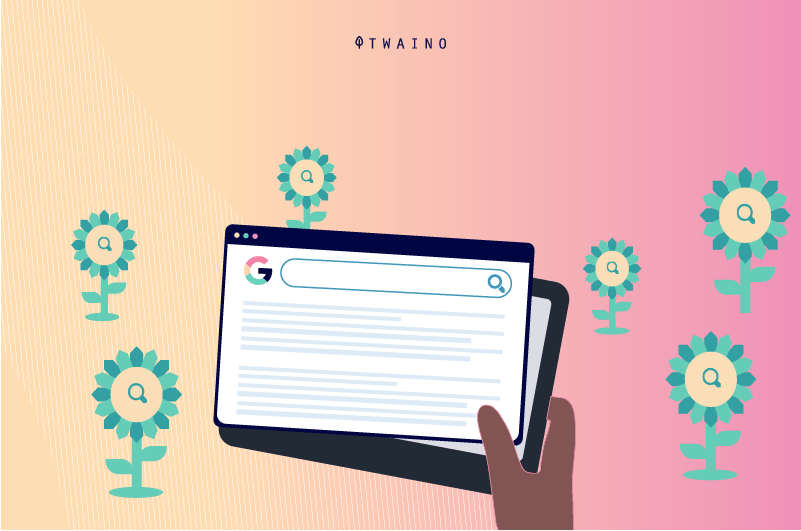
In fact, these people who come to you have already searched on search engines like Google or Bing and found your site.
The simplest method you can use to increase your organic traffic is to publish regular content on your blog. This is just one of the strategies you can use to attract new visitors to your website.
The area of online marketing that directly deals with improving organic traffic is SEO(Search Engine Optimization)
SEO is the set of strategies used to improve the positioning of a website or a web page in the search engine results pages commonly called SERP.
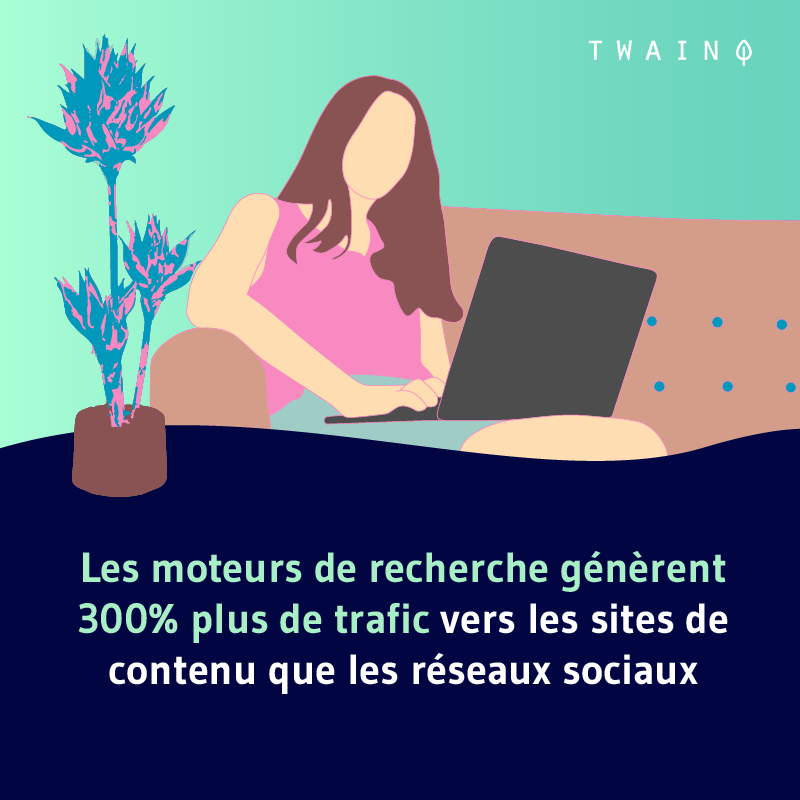
1.2. importance of organic traffic
Many people are not aware of the benefits that organic traffic can offer, and therefore do not value it highly. Here are some reasons why organic traffic is important to your marketing.
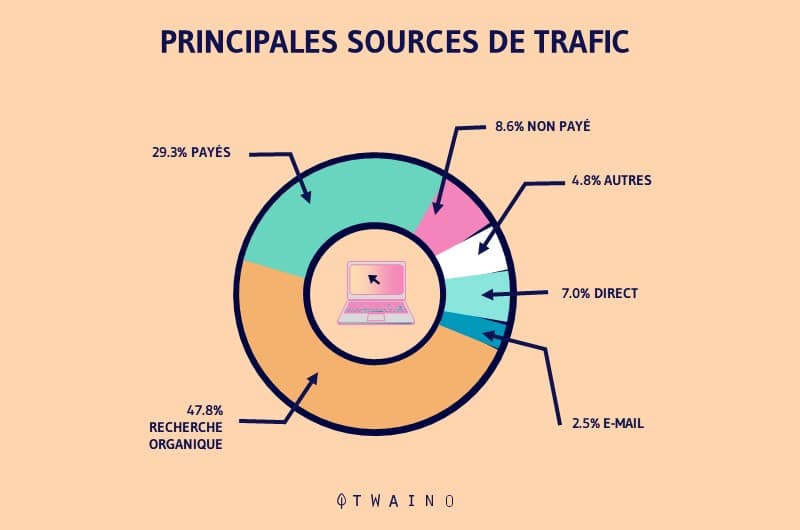
When using paid search, your traffic automatically stops and you lose your position when you stop your ad campaign or when there is a bad setting.
Whereas if you rank high in the organic results, your traffic remains stable even after a relatively short period of absence. This implies that your rank in the organic results is not as easily dislodged by other competing sites.
It is also important to take into account that 80% of Google users do not see these ads, not to mention those who use ad blockers in their browser. All this implies that most users are more interested in organic results and you will achieve more performance by occupying good positions in the latter
1.3) Where do you find the organic traffic in Google analytics?
The initial step to take to examine organic traffic in Google analytics is to access the channels report which you will find by clicking on the button Acquisition / All traffic / Channels
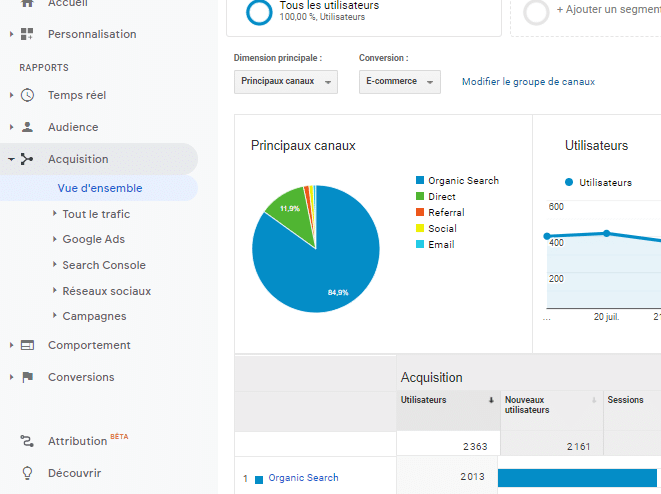
By doing so, you will see the different traffic of your website by their sources (organic, paid, direct, social, etc.). When you access the organic search, you will be able to examine the indicators that correspond to the organic traffic you are looking for
This report is crucial to optimally analyze the results of your SEO strategies. With this one, it is easier to evaluate practical elements such as:
- The landing pages that attracted organic traffic;
- The keywords that visitors have typed the most
- The different indicators that are relevant.
Google Analytics is a website analysis tool that Google has made available to you for free. Most webmasters use this application to visualize :
- The general traffic of the site ;
- The average time spent by visitors on the site;
- The number of pages visited;
- Traffic points: Direct, organic, paid, referred;
- The keywords that drove the organic traffic
- Etc.
1.4. No more confusion between direct and organic traffic
Direct traffic is the set of visitors who have inserted the URL of a site directly into the search bar of their engines. This traffic also includes users who clicked on a site’s link through the “Favorites“tab of a browser
Direct traffic can also be represented by the number of users who click on links obtained on non-indexed pages. The data of this traffic is not to be taken lightly, because generally speaking, this data comes from:
- Internal workers;
- Associates;
- Loyal users who come through the site to log in.
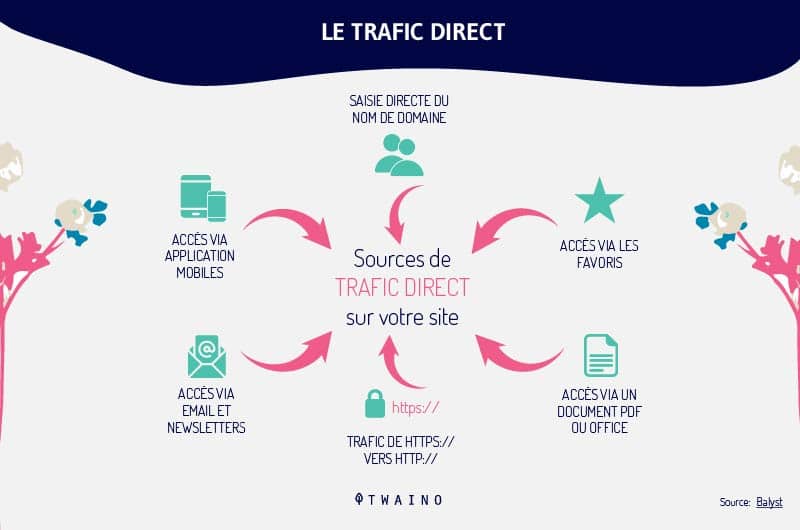
Direct traffic is proof that you are a known company. Especially if many people type your link directly into their browser, it is a good sign that your company is well known.
Regarding the difference between direct traffic and organic traffic, we can say that on the one hand we have search traffic and on the other hand directed traffic. They are both different sources
The traffic itself is the element that measures the size of a website. The ultimate and immediate goal of websites is to attract traffic, because lots of visitors means lots of customers, and customers mean revenue
Now you know what organic traffic means and the benefits it can offer. Let’s move on to how you can optimize this traffic to benefit your site.
Chapter 2: 10 tips to increase organic website traffic
In this second part, we will talk about the different techniques you can use to increase your website’s organic traffic.
These SEO elements that we will have to present to you are not the only ones you can use, but they should form the basis of your strategy.
By spending time on implementing these elements, you can improve the visibility and traffic of your website. It’s impressive to see the degree to which site administrators are eager to drive the most traffic to their site whether it’s for:
- An online store;
- A service website;
- A publishing site.
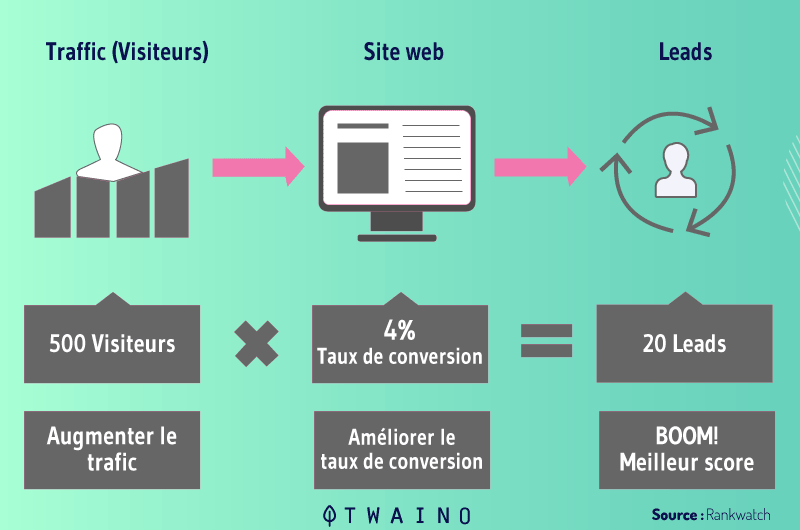
In each case, increased traffic equals:
- More product orders ;
- A high turnover;
- Increased revenue.
2.1. identify your competitors’ best performing pages
The more information you have about the SEO strategies employed by your competitors, the better your site will perform.
When you take the time to do an analysis and try to understand why your competitors’ sites are ranking higher than yours in the SERPs, you can see your weaknesses
This way, you can evaluate your competitors’ strategy and see if it works for you
To start with, you can try to find the pages of your competitors that have better SERP rankings to get an idea of where their organic traffic comes from or what is the source of it
When analyzing the top pages of your competitors, you will have to look at the following elements:
- The keyword and content gap;
- The link gap;
- How to change existing content.
However, here is a tool that can help you examine your competitors’ top performing pages
Go to the Ahrefs tool or SEMrushand insert the URL of one of your competitors’ sites.
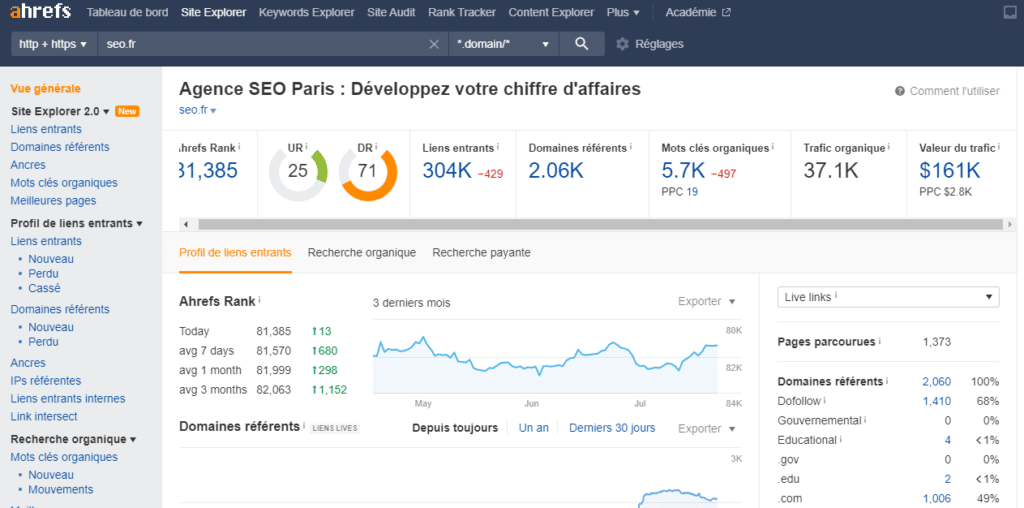
This will allow you to estimate the organic traffic of the site and thus get a generalized idea of its performance. You can also drill down into your surveys if you wish
You can also access the “Best Pages” tab on this same screen to filter visitors by determining more precisely which pages are performing the best organically
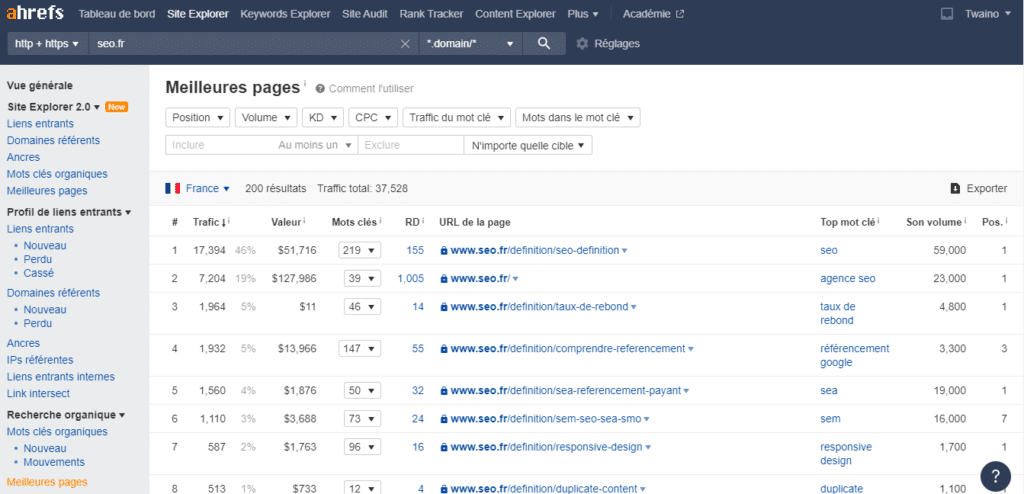
This is a simple method that will allow you to find the pages that offer more traffic to your opponents’ websites
It is absolutely necessary that you consider this task as a priority, in order to better understand the way these competing pages work. You can then develop a strategy that will allow you to divert some of your competitors’ traffic to your website.
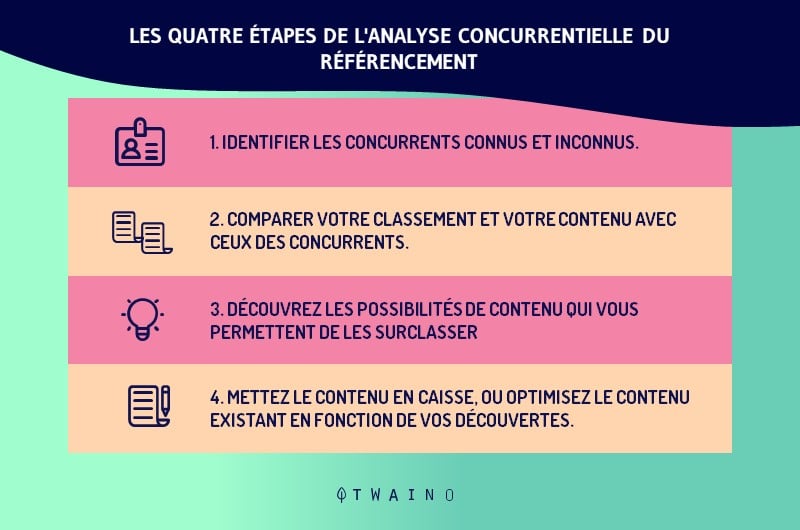
Think of it as a technique that reveals opportunities for you to seize or simply a prospect to dislodge your gains that would be located in the activity of your competing parties
This procedure is effective because it can also allow you to identify other websites that are competing with yours and that you had underestimated a little too much.
If you go to the “CompetitiveDomains“ tab of this tool, you will find a database in which is listed:
- Potential competing domains;
- The keywords used;
- And the estimated traffic.
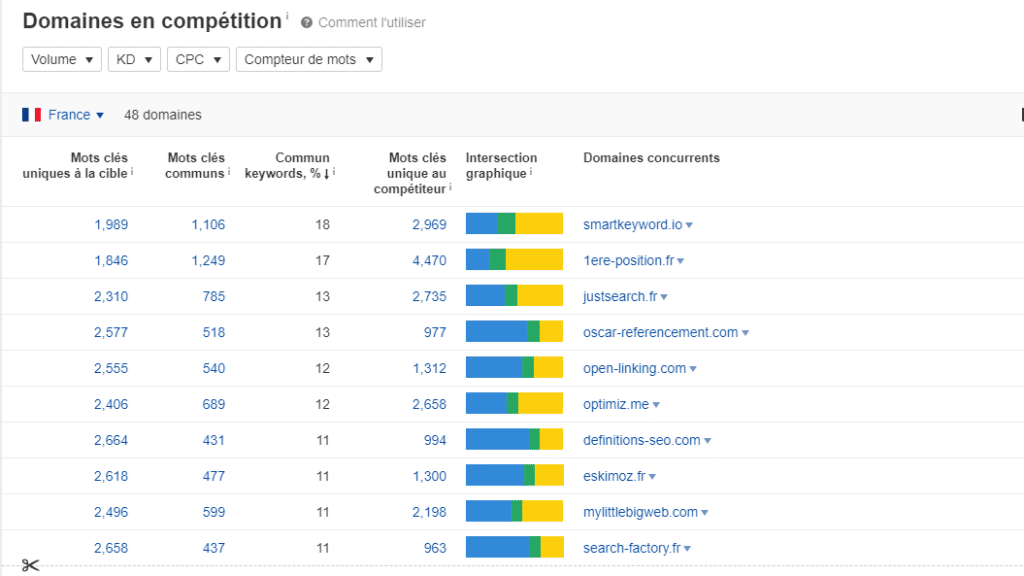
Then you can take each domain individually, analyze it with the tool to get detailed information on the pages that excel the most in your sector
2.2. Analyze keyword gaps to develop a content strategy
It is also important to focus your efforts on creating new content. But the most common mistake made even by SEO specialists is creating content just to create content.
In fact, content should be created with a specific goal in mind. Every piece of content created must have a specific purpose and rationale. It is therefore up to you to take the time to think about it and define a silky plan for the creation of your content.
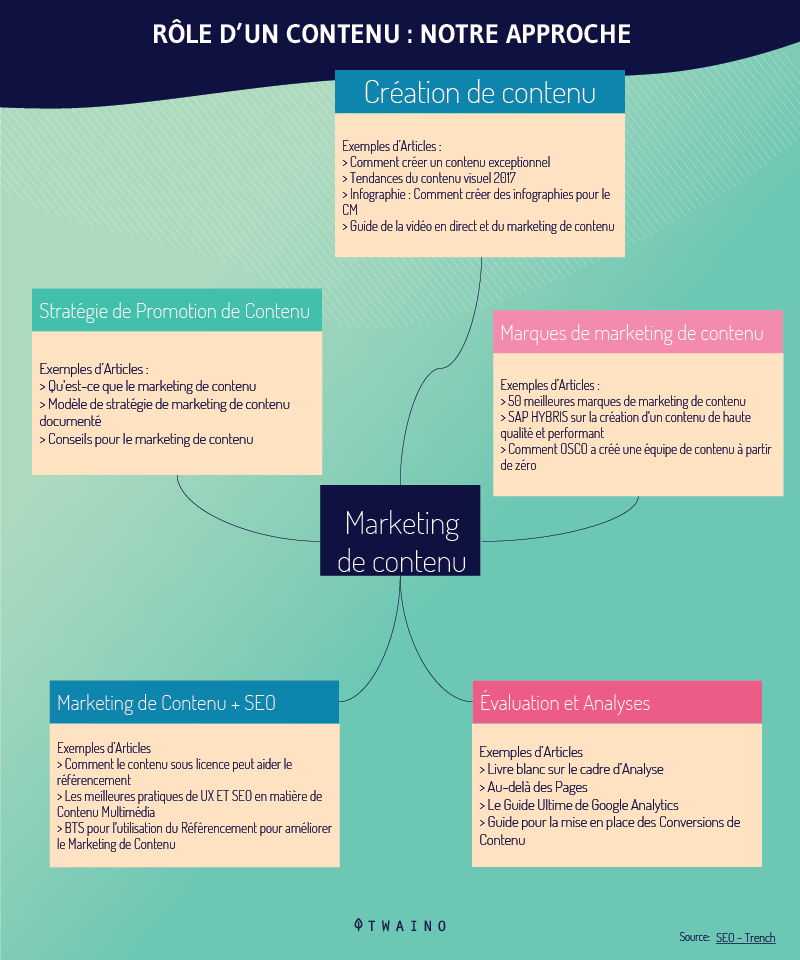
One of the effective methods for a content creation strategy is to be able to assess keyword gaps to identify keywords that your competitors are ranking better and that you are not yet using
By doing this, you can easily create new content that could contain those keywords, so you have topics that can fill the gap.
Click on the “Content gap” button in the Ahrefs tool, then enter your domain name in the corresponding box and reserve the other boxes for competitors.
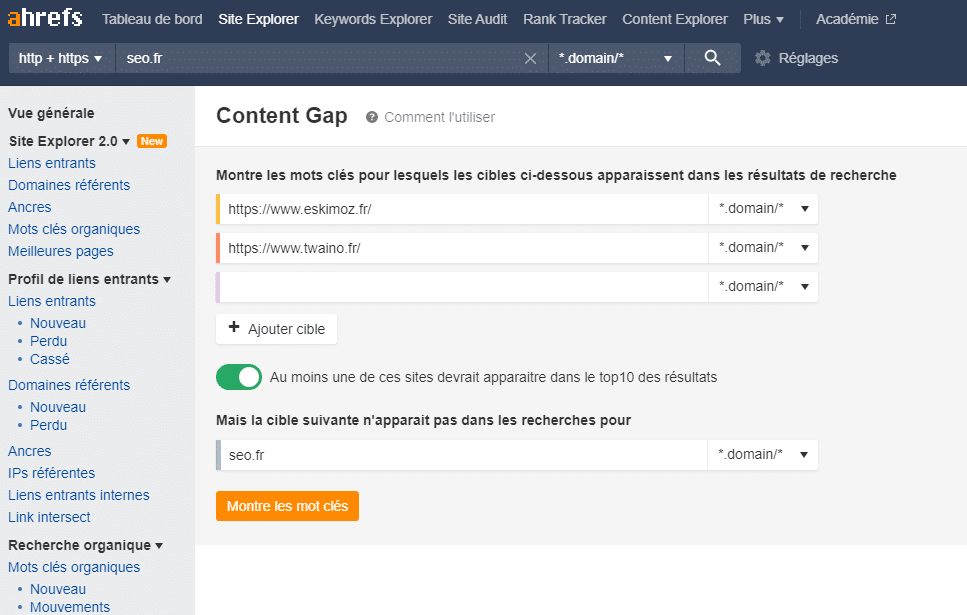
Then click on the “Show keywords” button, this will show you the keyword opportunities in detail
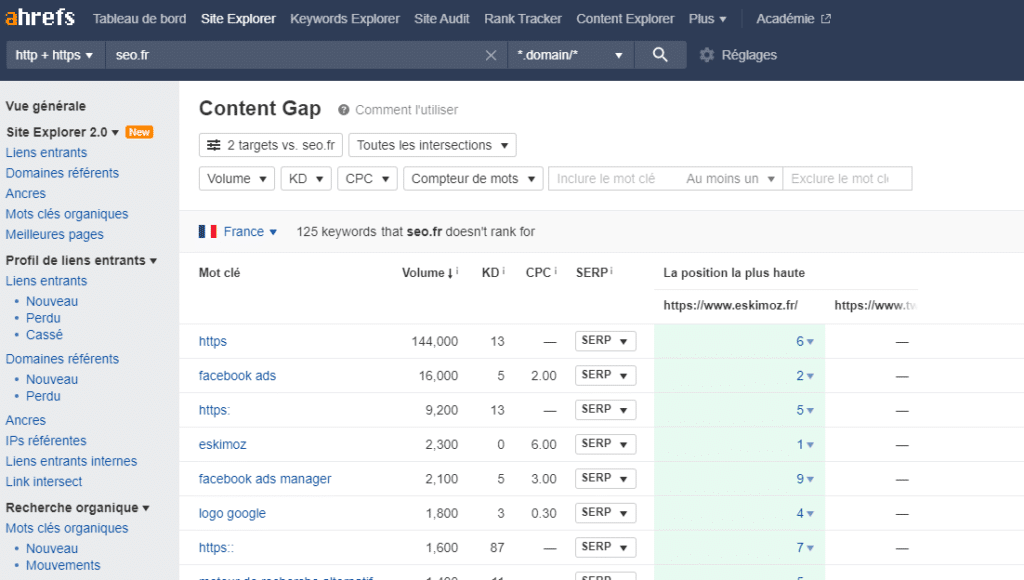
In the case of the Semrush tool, you have a similar option:
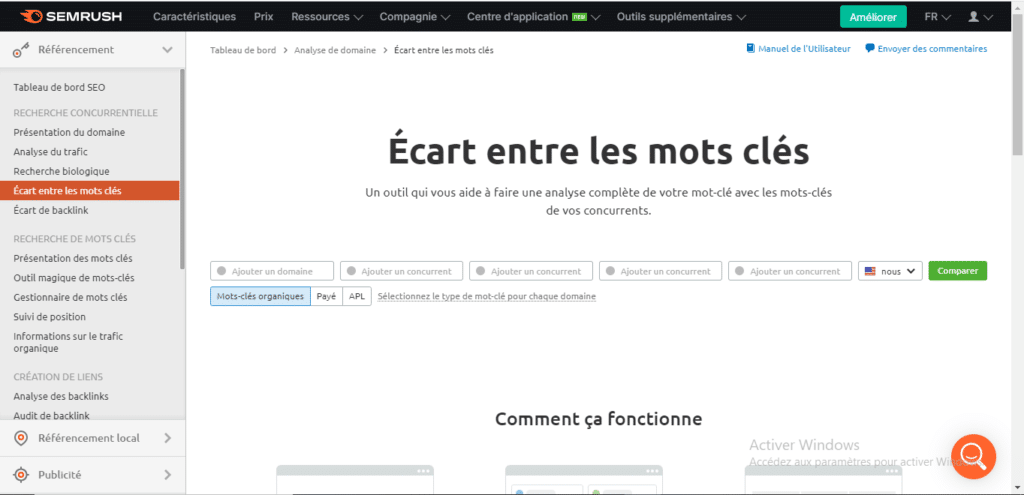
We will pay special attention to the comparison grid:
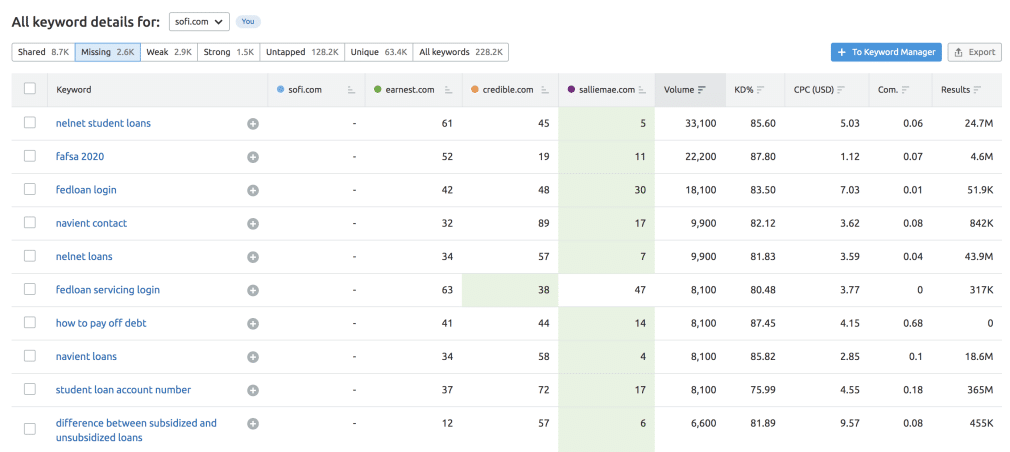
Source: Semrush
The filters you see at the top of the table can help you identify where there is a shortage of keywords related to the items at the top of the table.
You will see :
- Missing to designate the keywords by which all your competitors have positioned themselves and not you;
- Not exploited: this tab allows you to find the keywords for which at least one competitor has been positioned
It all depends on the reach of your website to perform a high scale keyword research
2.3. optimization of existing content
It is always better to start with the optimization of existing content especially since the optimization of content already indexed offers more easily gain than newly created content
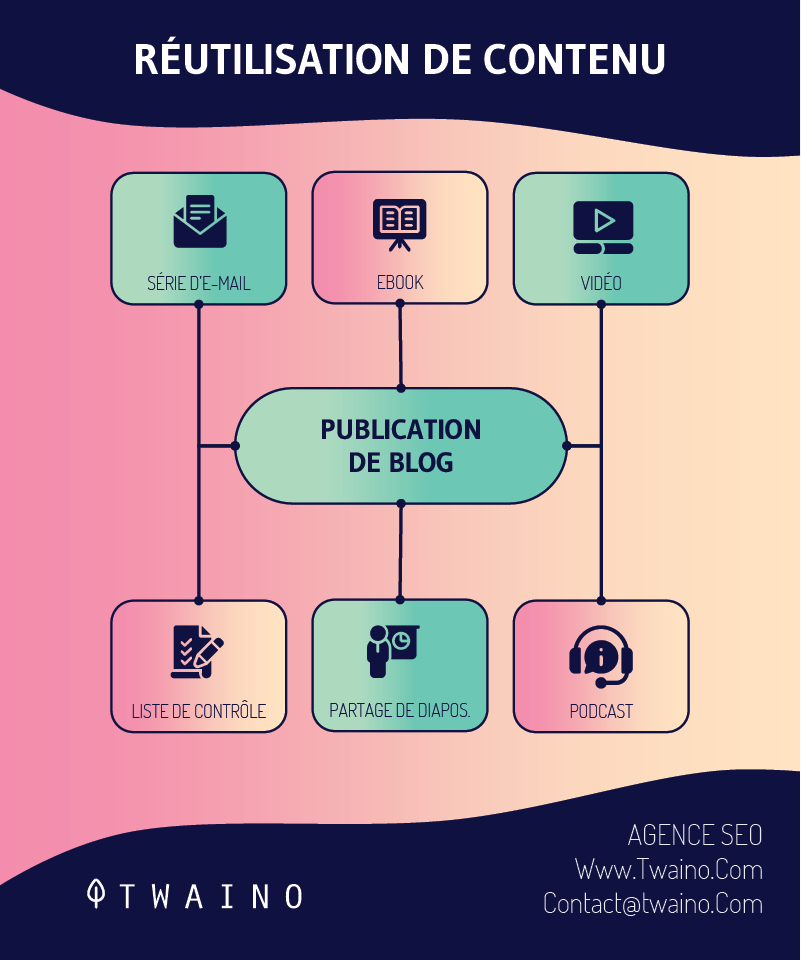
Here are some steps to take to better optimize your existing content.
- Identify content with great potential: The exercise is to identify the content pages that are ready to be optimized based on their current positions in the results pages, the keywords used and their potential for progress;
- Do keyword research: You can use the past tip on keyword variance to discover other terms or keywords to use in your content;
- Expand your content: Explore your topics in depth by producing quality content ready to compete for other positions in the SERPs.
2.4 Strengthen your positioning on the keywords on which your website is already positioned with the Search Console
There are plenty of ways to find keywords that can help your website rank higher in search engine results like Google, bing or Yahoo.
Below I will give you some tips and methods that can help you identify organic keywords that can increase the traffic rate to your website.
The idea will be to use the keywords that your site is already ranking for and try to optimize your website to consolidate and improve your ranking.
Google search console allows you to see your ranking on the keywords of your website
When you log into Google search console, click on “search results“, then choose“query“. You will see the keywords that are driving the most traffic to your site
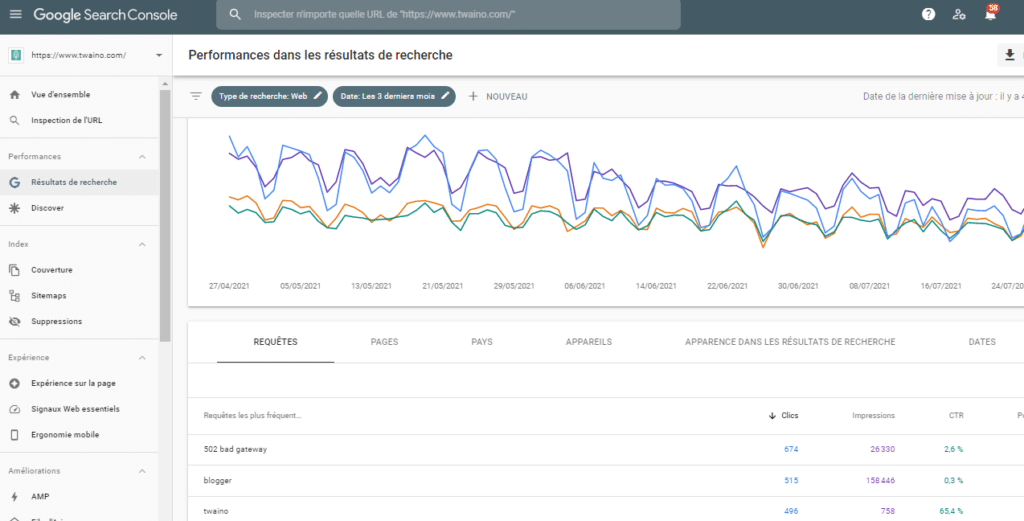
Another method is to focus only on keywords that offer a high quota of searches per month, but do not achieve a high page rank for your site
We advise you to optimize the pages formed around these keywords, with new elements of information, graphic illustrations or relevant images and relevant tags.
To get all the details on this strategy, here is my complete guide on Google Search Console.
2.4. Get authority backlinks through the use of Digital PR
One of the biggest challenges SEOs face is how to get a large amount of authority backlinks.
Backlinks are one of Google’s three main SEO factors. These are:
- Content;
- Backlinks;
- And Rankbrain
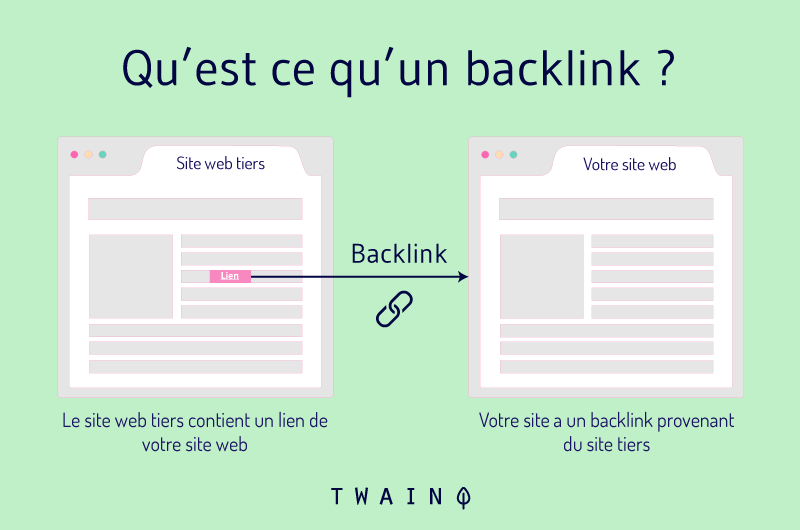
But while there are several link building techhttps://www.twaino.com/en/blog/seo/create-backlinks-ultimate-guide/niques that can earn you a lot of relevant links, the persistent problem is that it is difficult to implement these strategies effectively
Let’s review Google ‘s link requirements:
“The best way to get other sites to build relevant, high-quality links to yours is to create unique, relevant content that can naturally gain traction in the internet community. Creating good content pays off: links are usually editorial votes given by choice, and the more useful content you have, the greater the chance that someone else will find that content useful to their readers and link to it.”
But the technique we’re going to talk about here that can help you gain editorial links through content creation is the Digital PR or Relation Publique Numérique in French
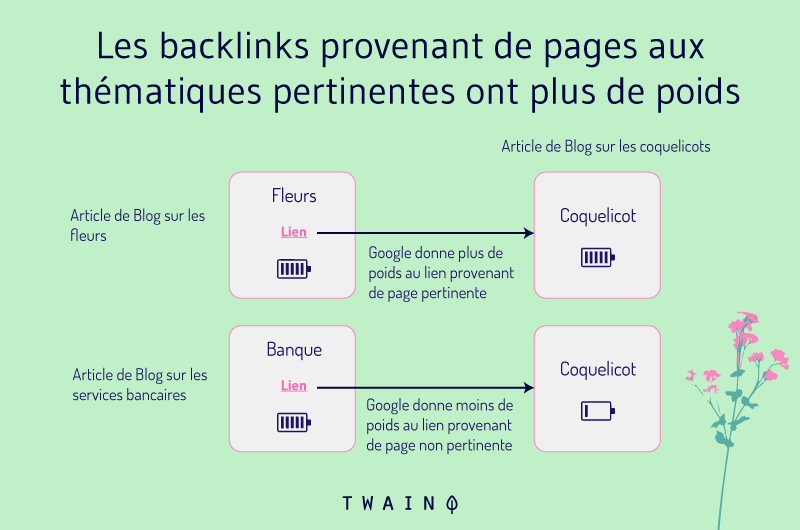
It can be thought of as creating or distributing content to journalists or editors who can link your content to their articles. This content can include:
- Infographics;
- Expert opinion;
- Research studies;
- Tools and calculators.
The Digital PR strategy promotes finding consistent and relevant content that could be linked with a solid promotion strategy.
Digital PR offers several other benefits that you should definitely be aware of
They allow
- Generate SEO traffic;
- Generate social engagement;
- Make the brand famous;
- Be in direct contact with the customer;
- Generate revenue through sales.
2.5. Collecting broken backlinks from your opponents
I’ve shown you in the previous sections how complicated it can be to get good backlinks. However, there is a new and effective technique that you can use. This one is a form of broken link building.
This technique would obviously require:
- Broken link research;
- Creating content around these links;
- Attempting to get those links to redirect to your article rather than to the already faded article.
There is one method you can use to get out of the game: try to find all the links that are directed to 404 pages on your opponents’ sites
Go to the Ahrefs tool, go to the “Outbound Links” tab, and click on the “Broken Links” section.
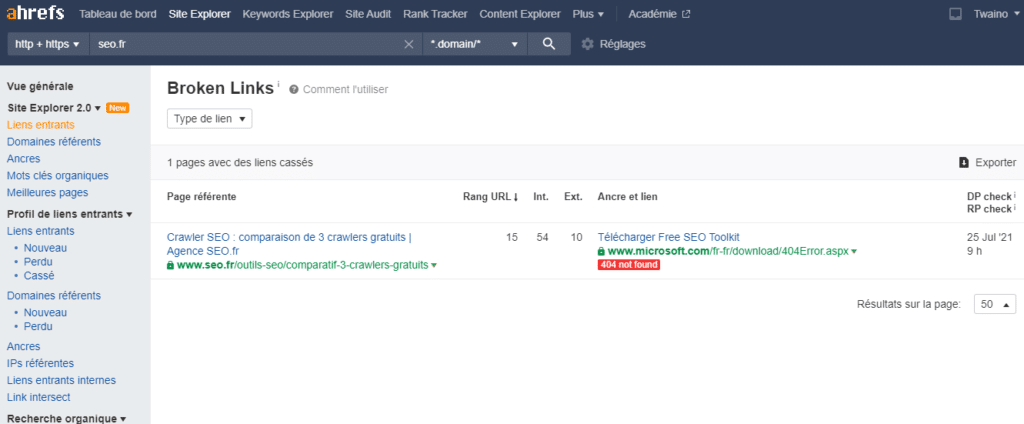
These pages transmit 4XX errors, and therefore do not get pagerank through the links that refer to them.
Filter these links by domains to get the different domains that point to these specific pages. Let’s take the example of the first link on the list we have just presented in the capture. When we open this link, we can clearly see that it is a 404 page:
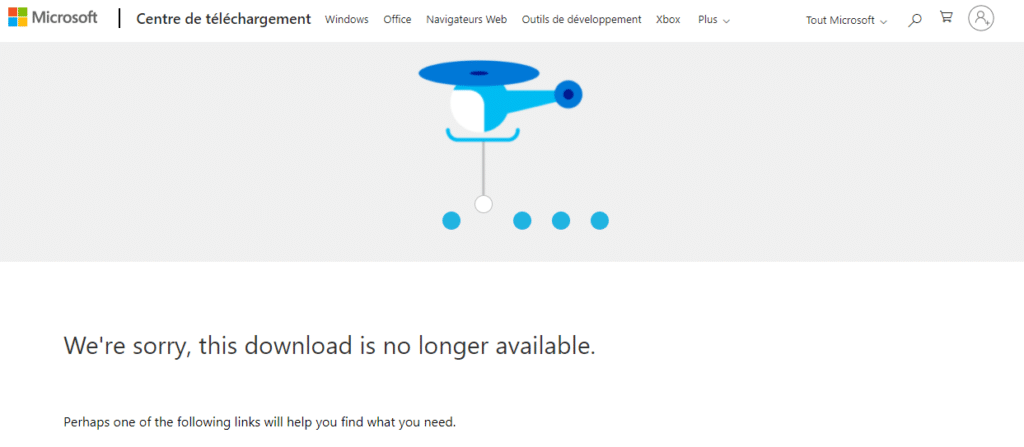
This is an opportunity for you to suggest or create your own content that could change or replace the broken link.
Alternatively, you can classify it as a precaution against a bad user experience, as long as someone comes to click on the dead link of a site
2.6. Use supporting content to show your expertise
Google seeks to rank the best page that offers a relevant answer to a given search query. That’s why it’s important to seek to rank well by producing valuable content
You need to think like an expert in your field in order to hope to rank high in the SERPs for your keywords. This means that you have to choose and master the right strategy to adopt to create supportive content
We are in the presence here, of the content optimization strategy according to the thematic cluster which wants all the contents of a website to be gathered around a theme
This is the concept of pillar pages that consists of grouping your content that discuss the same theme by linking them through hypertext links
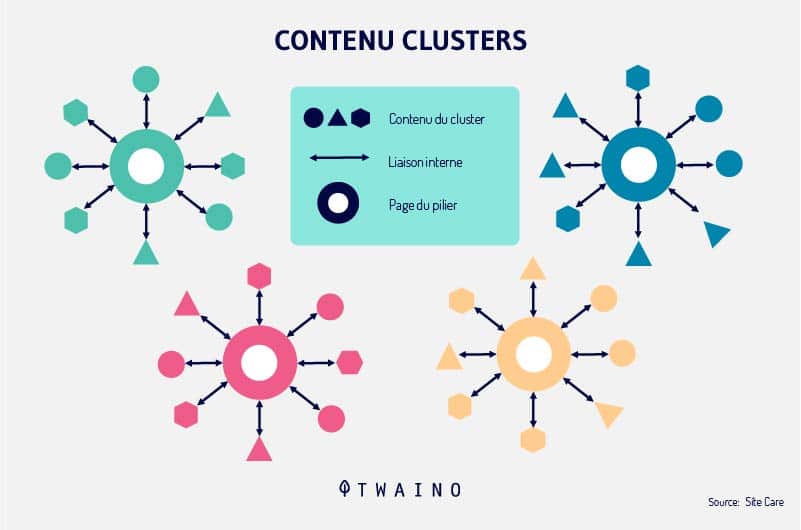
The main goal of this method is to help users and search engines to explore your pages in depth. Thus, they can browse all the pages of a theme of your site after a few clicks
It facilitates the search for information, because it allows you to organize your content well. In doing so, it offers your community a comprehensive content that addresses all aspects of the main topic.
The thematic cluster is composed of 3 elements:
- The anchor page;
- The hypertext links ;
- the cluster articles.
This strategy offers real advantages that can allow you to be well ranked in the search results and to generate a maximum of organic traffic
In particular, it allows:
- To exploit your keywords well;
- Reduce bounce rates;
- To make the user experience unique.
2.7. Optimize the images of the website
If you don’t think about optimizing images, you may be missing out on a chance to position yourself in a market that offers free traffic and that your competitors probably don’t even know exists

It’s true that image SEO strategy often involves tagging images with alt tags, but it goes much deeper than that. It’s important that you proceed to optimize your images effectively, as this could help you rank high in the image SERPs
To optimize for image search, you need to consider:
- Alt tags;
- The file name;
- Resizing images to their optimal dimensions;
- Reducing the size of files;
- Creating a detailed sitemap;
- Hosting your images on a CDN
However, going back and optimizing images that are already there can be time consuming. You can therefore set up a system so that if you upload an image, all of the above criteria are automatically checked, right from the start.
2.8. Avoid toxic links
Quality backlinks can give you a high ranking and on the other hand, poor quality or unnatural links can make you lose your ranking.
Any link belonging to a link scheme or created with the purpose of manipulating pageranks and site rankings in Google’s results pages is considered a violation of Google’s guidelines
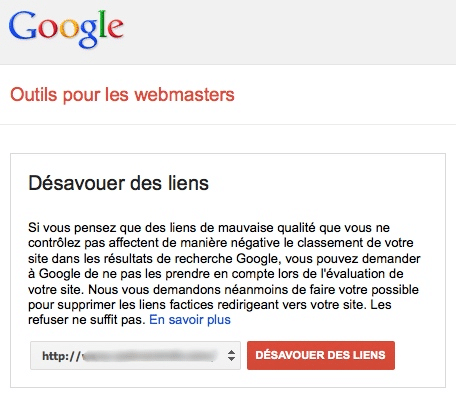
Source: Webrankinfo
These links are usually ignored, but they can harm your SEO, resulting in the loss of traffic.
That’s why it’s very important to clean up the toxic links you suspect or detect in your link profile
However, be aware that there are several reasons why your site may contain poor quality links:
- Buying links or links exchanged for products offered;
- Links created through exact match anchor texts;
- Large-scale guest article marketing campaigns;
- Negative SEO;
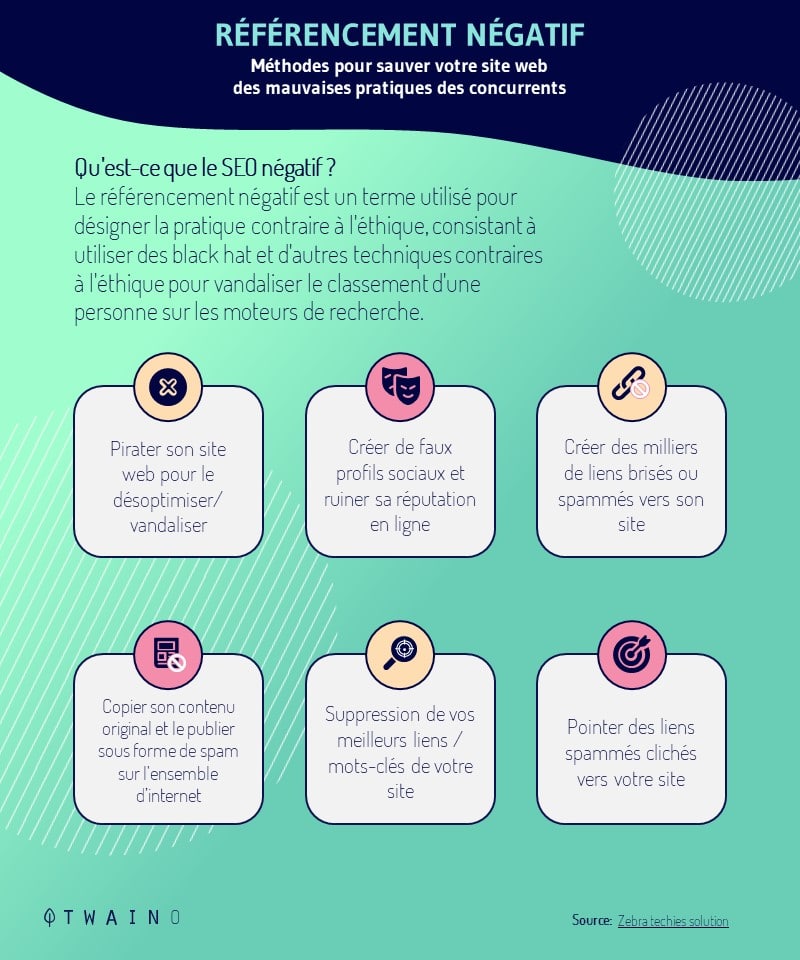
2.9. Other techniques to increase organic traffic
There are several other methods that can help you generate organic traffic to your website
2.9.1. Creating a blog for your website or online store
It is very important that your website or online store has a functioning blog. If your site does not have one, you must create one. It should be remembered that a blog is a very powerful tool to attract readers in order to generate more traffic and therefore more revenue for your business.
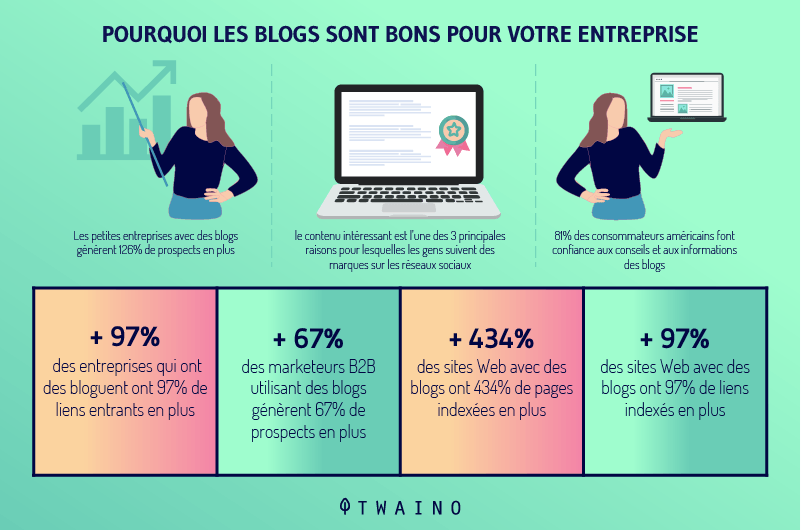
Such a result would be possible just with a blog for the simple reason that it also participates in SEO
Here are the characteristics that a blog that naturally attracts traffic must have.
- Make a punctual publication schedule: Here, you must first define a precise theme for your blog to ensure consistency between the present contents as well as the upcoming contents. Make sure that the chosen theme is a little broader to allow for the existence of sub-themes. Then, it is essential to take into account the rhythm of publication. This is crucial for your credibility with your audience. A blog that you feed every six months is not very interesting;
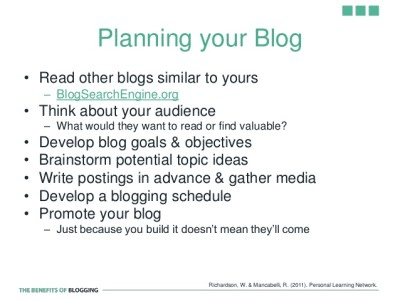
Source : Klusster
- Optimize URLs for your blog content: An optimized URL should be short and simple (avoid unimportant words like the, the of). After it should contain one or more keywords related to the content written, then conform to the hierarchy of the site to facilitate the crawl of Google;
- Optimize existing content: Old content can perform better than new content when it is updated and optimized properly;
- Optimize the blog to fit mobile: We are in the era of mobile search and it is clear that Internet users are accessing more and more websites and blogs via their smartphones. It is therefore important to arrange your blog by having a soft and easy to read display, an attractive model and images in the ideal format;
- Avoid repetitive tags: Tags increase the time spent on your content by directing users to similar content. But you have to be careful, because Google can penalize your blog if it notices an abusive behavior with the use of tags. Respect a list of 15 to 25 distinctive tags for contents that deal with the themes of your blog. This could protect you from any penalties.
- Optimize the images of your blogs: This point has been explored in the previous paragraphs, but it is important to draw your attention to it once again. It is important to know that images are very important for readers. They make content attractive since they can serve as illustrations for complex concepts;
- Insert and optimize metadata: Metadata are elements that are not visible to the readers, but they can contribute to the referencing of your blog and to get organic traffic.
2.9.2. Be dynamic on social networks
It is often said that if you are not present on social platforms, you simply do not exist
It is certainly important to create relevant content on your blog that brings real value to Internet users, but it is also important to be mentioned on external websites, i.e. backlinks as well as on the various social network platforms

When you promote your websites or blogs on social networks, you transmit to Google social signals that could contribute to the visibility of your site
The different forms of social signal are the different interactions in general. These include mentions, comments, subscriptions, shares, etc. And of course the links resulting from these interactions on social networks that redirect to your website.
2.9.4. Optimize the title and the meta description
The title and the meta description are two essential elements that can also contribute to the visibility of your page
They briefly describe the content of the page that the user will visit after clicking on the link. The challenge here is to be able to summarize in just a few words what the user should expect after the decisive click

It is important to insert in the meta description the basic elements that are covered in order to justify the interest in the title

Here are some criteria to observe to optimize your meta description.
- Observe the 155 characters required by Google to avoid having the meta description cut off;
- Make a summary of your content by showing Internet users that it provides an answer to their questions;
- Make the meta description captivating and interesting to entice people to click on your content;
- Write your meta description using the Yoast SEO plugin to avoid exceeding characters and be in the standard ;
- Track your click-through rate based on the number of times your article was displayed after a user’s query.
Summary
Organic traffic is a very useful and important element for websites, as it represents a factor for their SEO. It basically refers to all the people who visit your site from unpaid search results.
Increasing organic traffic offers financial and competitive advantages to webmasters who want to take their business to the next level. But first they need to know the methods that can help them get there.
With this in mind, in this content we have presented the effective tools and tips to attract more organic traffic to your site in order to take your SEO to another level
Thank you for following me.

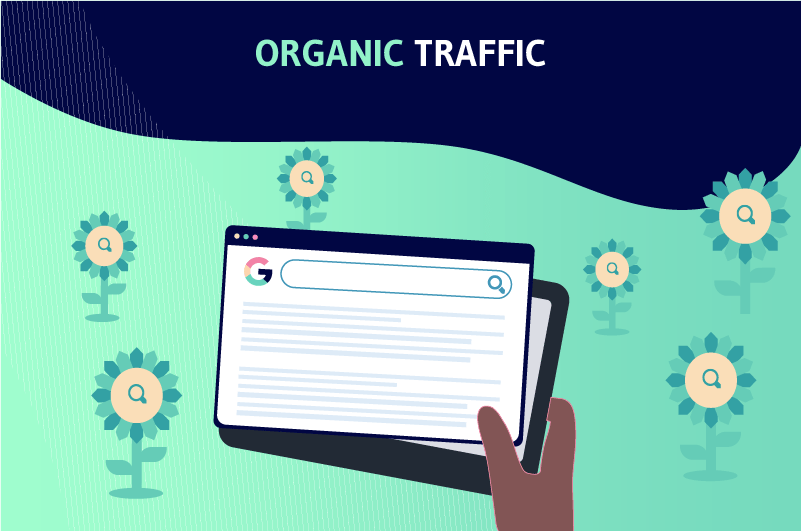


I am glad I found this article. I am a newbie in SEO, so I am interested in all SEO-related aspects. Thank you for posting the excellent article. Keep it up!